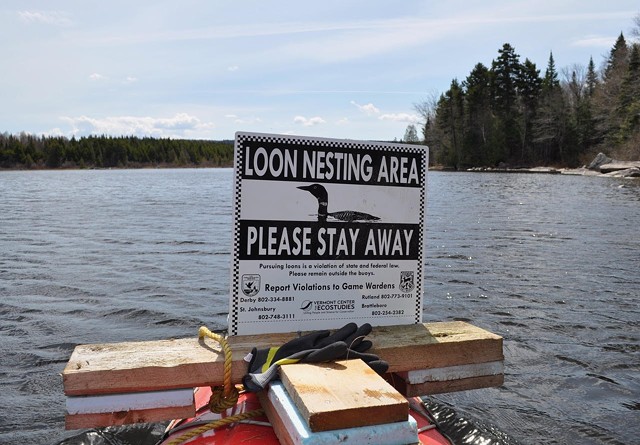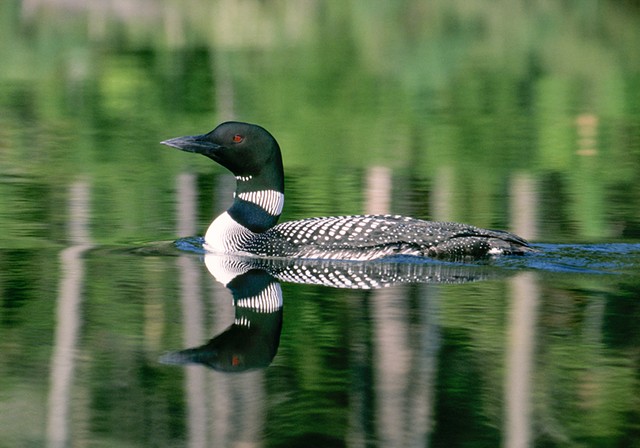
- Courtesy of Becky Scott
- Warning signs on Big Averill Lake in Norton
Vermont’s annual loon protection budget is seeing a long-term expansion this year, thanks to a settlement from a 2003 oil spill in Buzzards Bay.
A grant of about $450,000 will be used to improve protection for loon nesting sites in Vermont lakes, and new mapping and education tools, said Eric Hanson, a biologist for the Vermont Center for Ecostudies who works on loon management in partnership with the state Department of Fish and Wildlife.
Hanson said the center’s Vermont Loon Conservation Project will also use the money over the next several years to revamp the database of the volunteers who provide information about the large migratory birds and their nesting sites at lakes around the state.
“And I’ll be able to get safety gear for ice rescue,” said Hanson, noting sometimes chicks or adults are found frozen but alive on lake surfaces. “We’ll be able to capture them and give them a second chance.”
With its distinctive black-and-white appearance and loud, unique calls, the common loon is a popular and well-known bird. Nearly 2,000 Vermonters pay an extra $26 for a conservation license plate that features a loon, and there are several vanity plates with the word “loon” in them as well. The Canadian 1-dollar coin is known as the “loonie" for the loon etched on one side.

- Vermont Fish & Wildlife
- Vermont loon
“I’ve been intrigued with loons since I was a kid,” said Sherry Marshall, who with her husband Hank is spending retirement as an active loon-watcher on several tiny Northeast Kingdom ponds. As a small child in the late 1950s, Sherry recorded loon calls at her family’s cabin in northern Maine, and the family would play the calls back as they sat by the fire at night.
“It’s a different kind of wildness,” she said of the large lake where her family spent its summers. “It’s not uncommon to have 19 to 25 loons grouped together. You can be swimming and they come up next to you.”
The Marshalls regularly visit a half-dozen ponds, some accessible only by foot, to observe the loons through binoculars and gather information for Hanson. They’re part of a network of about 35 volunteers that Hanson relies on.
“There are some lakes I haven’t visited in 15 or 20 years because the volunteers are so good at keeping me informed,” said Hanson, who has been working on loon conservation since 1998. He supplements his conservation work with a position on the ski trail staff at the Craftsbury Outdoor Center in the fall and winter.
Loons live on North American lakes, and like many species they suffered population declines as a result of habitat loss, hunting and other factors in the 20th century. By the 1980s, they had almost disappeared from Vermont, said Hanson.
Because loons nest on lake shores, small islands and in marshes, they are vulnerable to the fluctuating water levels that come with small-scale hydropower dams, a common feature of the landscape in the 19th century. Hanson speculated that much of the population loss happened in that era.
Hunting was probably a fairly big issue, not necessarily for food but for sport,” he added.
Fluctuating lake levels are still a problem, said Hanson, although he said power companies like Coaticook River Water Power in Quebec, which controls water levels in some Vermont lakes and ponds, cooperate with conservation programs that try to keep levels stable. Predators such as eagles also take eggs and loon chicks.
The Vermont Institute of Natural Science started work on restoring the loon population in the 1970s, Hanson said, and now there are an estimated 350 of the birds in the state — a healthy number, said Hanson. There are about 100 nesting pairs, he said.
Hanson uses his typical annual budget of about $35,000 to maintain warning signs that help boaters avoid loon nesting areas, build and fix nesting rafts, rescue birds that have been caught in fishing line and publicize the dangers of lead fishing sinkers, which kill loons every year.
“We’ve been pretty low-budget compared to other programs,” Hanson said.
The grant will change that. The money comes from a share of the multi-million-dollar federal settlement that the Bouchard Transport Company reached in 2017, nearly 15 years after a massive oil spill soaked 90 miles of shoreline in Buzzards Bay in Massachusetts and Rhode Island, killing birds and other wildlife. Hanson expects to spend the money over the next several years.
One goal is to remove more lead from circulation. A 2007 law cut lead poisoning mortality rates significantly in water birds, he said, but recently he has seen those deaths rise, and he doesn't know why. The loons, which are known for their powerful diving and underwater swimming, can ingest the sinkers. Hanson plans to start a lead sinker buyback program in 2022.
He’d also like to install some game cameras to get a better idea of why 20 to 30 percent of loon nests fail to produce chicks, possibly as a result of flooding, predation, or abandonment.
“This grant can be used to shore up existing programs and make the program strong,” Hanson said. “Hopefully, it will help us get through the next 10 years really well.”













Comments
Comments are closed.
From 2014-2020, Seven Days allowed readers to comment on all stories posted on our website. While we've appreciated the suggestions and insights, right now Seven Days is prioritizing our core mission — producing high-quality, responsible local journalism — over moderating online debates between readers.
To criticize, correct or praise our reporting, please send us a letter to the editor or send us a tip. We’ll check it out and report the results.
Online comments may return when we have better tech tools for managing them. Thanks for reading.